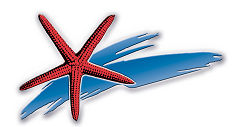A short glossary
- Established species: more than three records in the last 25 years
- Unsettled species: less than three records in the last 25 years
- Apical lobe: small fleshy lobe at the snout tip of some rays.
- Caudal: pertaining to the tail region.
- Caudal sting: enlarged, dagger-like bony structure on the tail of some rays; sometimes abbreviated to ‘sting’.
- Claspers: reproductive parts of the pelvic fins in male sharks, rays and chimaeras used for transferring sperm to the female; enlarged and paired in adults.
- Demersal: living on or near the seafloor; incorporates both benthic and benthopelagic organisms.
- Denticle: type of scale (placoid) of a cartilaginous fish.
- Disc: the combined head, trunk and enlarged pectoral fins of many rays.
- Egg case: strong casing surrounding the fertilised eggs of some sharks, skates and chimaeras; in rays, a protective case made of collagen fibres used to protect the developing embryo; flattened and rectangular in shape and laid on the seafloor.
- Elasmobranch: major group of cartilaginous fishes including the sharks and rays.
- Gill slits: long, narrow respiratory openings on the ventral head in rays.
- Oviparous: producing egg cases that hatch after being ejected from the body of the parent female ray.
- Pelvic fins: paired fins (rarely joined) positioned on the ventral surface between the head and vent.
- Rostrum: a projecting snout; anterior part of the skull of some rays.
- Skin fold: an area where skin is bent over upon itself, forming a fleshy ridge.
- Snout: that part of the head in front of the eyes; direct distance from the eye to the anteriormost tip of the head.
- Spawning ground: geographic area where reproduction takes place.
- Spiracle: a respiratory opening behind the eye in sharks and rays.
- Sympatric: living together in the same spatial or geographic area.
- Teleost: large group containing most bony fishes.
- Thorn: large dermal structure on the skin of many rays; tips vary from sharp to blunt.
- Viviparous: producing live young from within the body of the parent female.
